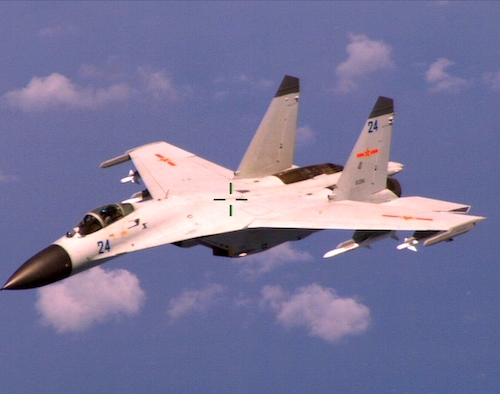J-11 Responsive Dragon
Summary
| Category | Combat Aircraft |
| Origin country | 🇨🇳 China |
| Manufacturer | Shenyang |
| First flight | 1 January 1998 |
| Year introduced | 1998 |
| Number produced | 442 units |
Description
The Shenyang J-11 emerged from China's strategic shift toward Soviet military hardware following the 1989 Tiananmen Square protests and a subsequent Western arms embargo. After acquiring Sukhoi Su-27 fighters, China entered into a US$1.2 billion agreement with Rosoboronexport in 1996, permitting the Shenyang Aircraft Corporation (SAC) to license-produce 200 Su-27UBKs using kits supplied by Russia's Komsomolsk-on-Amur Aircraft Plant (KnAPPO). The first two aircraft, designated J-11, were completed in December 1998, the same year as the type's first flight, but faced initial assembly problems that required Russian technical assistance. Production continued with increasing incorporation of local airframe parts, evolving into the J-11A variant around 2000. By 2004, China's development of the J-11B, a heavily indigenous version, violated the co-production agreement and reportedly concluded the official arrangement, though significant engineering challenges remained, particularly in maturing the domestic WS-10 turbofan engine as a replacement for the Russian powerplants.
Derived from the Sukhoi Su-27 airframe, the J-11 series features a twin-engine, twin-tail design optimized for air superiority. Early J-11A models retained many Russian subsystems but introduced improved domestic avionics and cockpit displays. The subsequent J-11B variant represents a significant technological divergence, incorporating a lighter airframe through the greater use of composite materials and a suite of Chinese subsystems. These include a Type 1493 radar, a digital fly-by-wire control system, a glass cockpit, and indigenous hydraulic, fuel, environmental control, and molecular sieve oxygen generation systems. Later upgrades, such as the J-11BG, introduced further enhancements like an Active Electronically Scanned Array (AESA) radar, a helmet-mounted sight, and missile approach warning systems.
The J-11 is equipped for a range of air-to-air and air-to-ground missions, centered around a ten-hardpoint weapon carriage system. Standard internal armament consists of one 30 mm Gryazev-Shipunov GSh-30-1 cannon with 150 rounds. External pylons located under the fuselage, air intakes, and wings can carry a variety of munitions. Its air-to-air missile capabilities have expanded with successive variants, initially including the Russian Vympel R-27 and R-73, and later integrating Chinese missiles such as the PL-8, PL-9, and the beyond-visual-range PL-12. Upgraded models like the J-11B and J-11D are capable of deploying more advanced munitions, including the PL-10 and PL-15. For ground-attack roles, the aircraft can be armed with unguided rocket launchers and free-fall cluster bombs.
In service with the People's Liberation Army Air Force (PLAAF) and Naval Air Force (PLANAF), the J-11 has been a key asset in China's air power projection. In March 2011, PLAAF J-11Bs participated in "Shaheen 1," a joint operational exercise in Pakistan with the Pakistan Air Force. The aircraft gained international attention on August 19, 2014, when a PLANAF J-11B intercepted a U.S. Navy P-8 Poseidon patrol aircraft over the South China Sea. The Pentagon described the encounter, which included close-proximity passes and a barrel roll over the P-8, as "unsafe" and "unprofessional," while China maintained its pilot acted professionally during surveillance by the U.S. aircraft. The J-11's service has also seen operational losses, including a J-11B crash during a training exercise in December 2017.
Main Variants
- J-11A: An upgraded variant of the baseline J-11 featuring greater domestic content, improved avionics, and modernized cockpit displays.
- J-11B: A Chinese-developed multirole variant featuring extensive domestic subsystems, including a new radar, a lighter airframe using composites, and the Shenyang WS-10 engine on later blocks.
- J-11BS: The tandem two-seat combat-capable trainer version of the J-11B variant.
- J-11BH: A naval version of the J-11B fighter adapted for operations with the People's Liberation Army Naval Air Force.
- J-11D: A proposed advanced variant featuring AESA radar, an IRST sensor, and greater use of composite materials, though the project was reportedly set aside.
Technical specifications
| Version: J-11A | |
|---|---|
| Crew | 1 |
| Operational range | 3,530 km (2,193 mi) |
| Maximum speed | 2500 km/h (1553 mph) |
| Wing area | 52.8 m² (568.8 sqft) |
| Wingspan | 14.7 m (48.2 ft) |
| Height | 5.9 m (19.4 ft) |
| Length | 21.9 m (71.9 ft) |
| Service ceiling | 18,500 m (60,696 ft) |
| Empty weight | 16,380 kg (36,112 lbs) |
| Max. takeoff weight | 33,000 kg (72,752 lbs) |
| Climb rate | 300.0 m/s (984.3 ft/s) |
| Powerplant | 2 × Shenyang WS-10A "Taihang" afterburning turbofans |
Current operating countries
| Country | Units | ||
|---|---|---|---|

|
China | 365 (+50) | |
All operators
Armament

